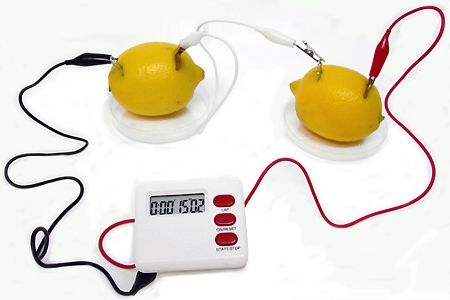For our lab, we decided to experience with lemons and their ability to conduct electricity. Through using lemons as a form of batteries, our attempt was to see how many may be required to light one small digital clock. The voltage that one lemon can produce was able to be explored through collecting data in this experiment. Based off the voltage of one lemon, we were able to analyze how many were needed to power the clock. To ensure that we were able to do all of this, we needed a number of different materials:
- Lemons (multiple)
- Copper Nails/Tacks
- Galvanized Nails (Zinc)
- Alligator Clip with cables, multiple
- One Voltage Reader
- A Digital Clock
- LED Light Bulbs, if you wish
The type of battery that is created when you combine the use of zinc nails, copper nails, and the lemon is a voltaic battery: a battery that changes chemical energy in to electrical energy. A voltaic battery is made up of positive and negative electrodes and an electrolyte, which is a solution that can conduct electricity. In this case, the electrodes are the zinc and copper nails, and the electrolyte is the acid within the lemon juice. Electrons get lost from one electrode, which creates a flow of electricity.
To create this battery, we began by gathering all the necessary materials. Once we had everything we needed, we inserted a galvanized nail into the side of two lemons, and then interested a copper tack into the direct opposite side of the same two lemons. After each were inserted, we then connected the end of an alligator clip to the zinc nails in each lemon, and a separate one to the end of the copper nail in the lemons. The opposite end of each alligator clip was then connected to the tips of the voltage reader probes. We where then able to read the voltage that these two lemons were producing. We had an issue at first when we were doing this; we were reading and converting on the voltage meter wrong. We originally thought we read 182 milli-volts, but this calculation was incorrect. After talking to Dr. Shatz and Tom Vales, we were able to come to the conclusion that we were actually reading 1.82 volts, and this is roughly around what we were suppose to be reading. This problem that we ran into could have been caused by us misreading the levels, or that we had a faulty connection with the voltage reader. After we realized we were reading things incorrectly on the voltage reader, we decided to un-clip the alligator clips from the voltage reader probes, and then attach them to the two severed wires of the digital clock. Once we did this, the clock turned on! We had success in turning the digital clock on. We recorded this data.
We also had ran into a second issue as well, but this happened before we even got as far as we did in the above mentioned time we did the experiment. When we first started this experiment, we did not have the copper tacks. Since we did not have copper tacks, we decided that we could try and use some pennies since they are made up of copper. We had the zinc nails, so we sliced the lemon with a knife in five separate places in a straight line on opposite sides of the lemon, so there was one straight line of five slits, and then another straight line of five slits on the opposite side, making a total of ten. Five galvanized nails were inserted in one row of the five slits, and then five pennies were interested in the other end. We wrapped some un-coated wires around one nail and the diagonally crossed over to wrap the same wire around a penny. We repeated this step to all of the remaining nails and pennies. After this was done, we then did the same as above where we connected the alligator clips to the voltage reader probes. We did not get a voltage read. We thought this strange, s we just decided to attach the clips to the clock, and figured maybe the voltage probe was having a faulty connection. The clock did not light up. So, we had two more lemons, and we did what we did to the previous one. We attached each lemon with an alligator clip to a galvanized nail and a penny. We had thought that adding more lemons would make the battery stronger, and that now the clock would be able to be powered. In the end, it never worked. After discussing with our team and Tom Vales, we realized it was probably due to the fact that we were using pennies; pennies are not 100% copper. The next class period we brought in the copper tacks, and then the experiment was able to be successful with one lemon. The process I have just explained can be seen in the image below.


The above is an example of a voltaic battery.
In conclusion, we realized that lemons are not a practical source of energy, but they do put in to perspective our energy usage and needs. A lemon cannot power a motor, and cannot put out enough energy alone to light a small LED bulb. Maybe if you had unlimited lemons you would be able to power the world, but that is literally impossible. In the end, we were able to power one small digital clock with only two lemons, but many more are needed to power something of a stronger energy.